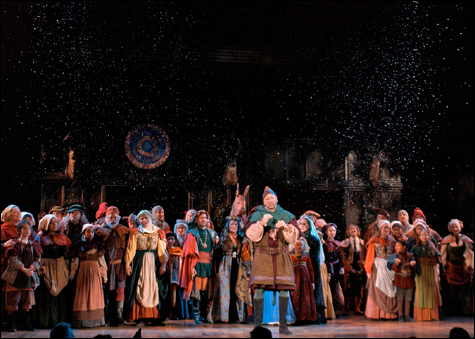
David Coffin and the Revels chorus |
| Christmas Revels | Sanders Theatre, Memorial Hall, Harvard University, 45 Quincy St, Cambridge | December 14-30 | $25$47; $15-$37 children under 12 | 617.496.2222 |
In the endearing spirit of “it takes a village” — rather than a shopping mall — to celebrate the holiday season, the 37th annual Christmas Revels will mirror the village traditions of the Balkans in its music and dancing. Led by the women’s world-music group Libana and the folk-dance troupe Mladost, this year’s cast will make Sanders Theatre reverberate with the unfamiliar sounds of the gaida (bagpipe) and the gudulka (a bowed folk fiddle with unusual stringing) as they accompany the guest performers and the Revels chorus of 40 adults and 18 children.“Just about everything is different in this year’s Revels,” says Patrick Swanson, long-time director of the annual extravaganza. “We’re taking on the Balkans, a word that’s come to mean breaking into little bits. As political frontiers change, the cultural borders remain the same.”
The Revels chorus has been coached by Sue Robbins, founder and artistic director of Libana, in the high, whining pitches and close harmony of the songs culled from Bulgaria, Macedonia, Slovenia, Serbia, Bosnia, and Croatia, all in arrangements by musical director George Emlen. After asking this reporter to hold the phone away from her ear, Robbins sang a phrase of a fluid, piercing song. “A lot of the musical scales are different, with uneven meters to the rhythms — 5/8, 9/8, rather than 4/4,” she points out. Another difference is the presence of a “drone note, similar to a bagpipe. This one constant note is sounded, with the melody over it — it’s found in some but not all of the music of the region.”
The challenging rhythmic count is also crucial to the complex steps of the folk dances. Petar Petrov — a professional dancer with Rodhopa, the Bulgarian National Dance Company, from 1988 to 1995 — has taught portions of the folk repertory to Mladost, whose members, ages 16-20 (“maldost” means “youth”), are alums of past Revels children’s choruses. “The footwork in Bulgarian folk dancing, he explains, “is similar to Irish dancing — quick steps — but the Bulgarian dances have lots of upper body movement. The rhythms are difficult: 7/8 or 11/16 or even 7/16 + 7/16 + 11/16, sometimes with combinations between two of them at the same time.”
Both Petrov and Robbins will join their charges in performing what’s new material for Revels. But Swanson wants to assure long-time fans that there’ll also be the usual staples: the Pinewoods Morris Men, and “Dona Nobis Pacem,” and the Sussex Mummers’ Carol. And David Coffin, on-stage heir to late Revels founder John Langstaff, will again lead willing audience members in “The Lord of the Dance.” “If there are 1100 people in the audience,” Swanson reminds me, “around 600-700 of them will dance out into the Sanders lobby at intermission.”
On the Web
Christmas Revels: www.revels.com